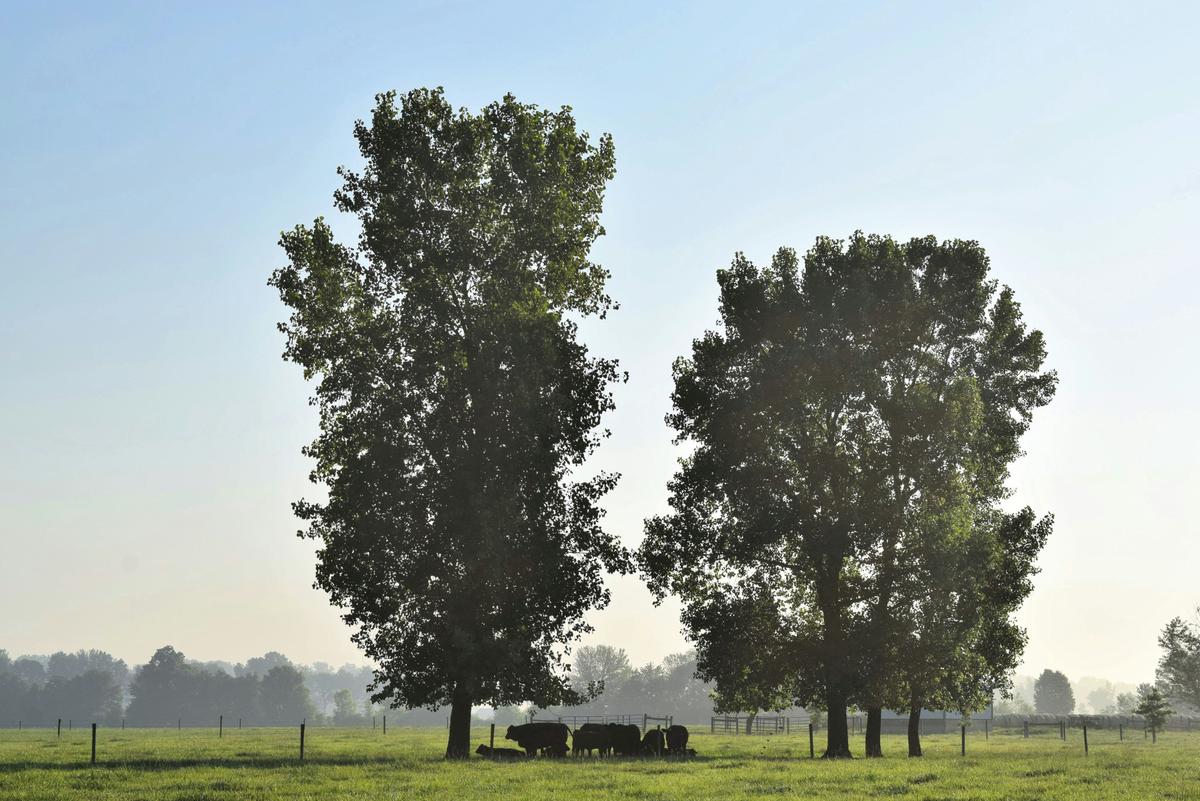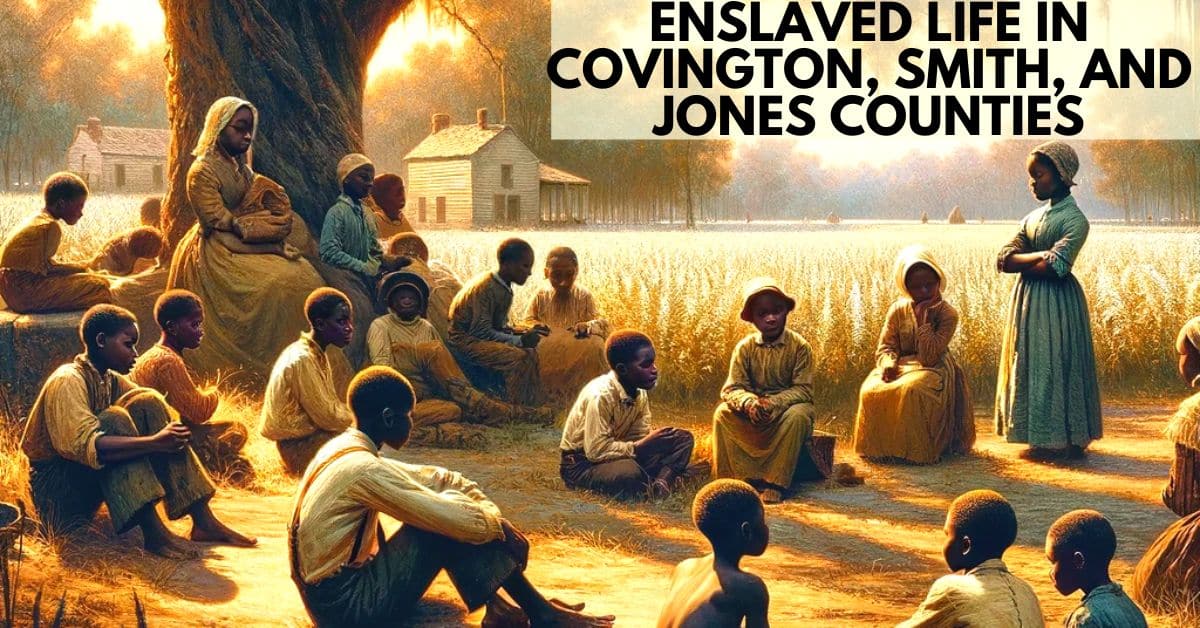Between the years 1830 and 1865, the plantations of Duckworth, Speed, Nichols, and Johnson in Covington, Smith, and Jones Counties in Mississippi played host to numerous realities experienced by those who were enslaved within their boundaries.
The lived experiences and resistance of these individuals, the roles they played within Mississippi’s economic system, and the impact of their emancipation on the region’s socioeconomic fabric are integral to understanding this complex history.
This first-hand look into the realm of these plantations serves to unfold the layers of the everyday lives of enslaved individuals, illuminating their struggle, resilience, and impact on society, illuminating a forgotten aspect of history that is oftentimes overlooked.
I encourage you to discover the history of my great-great-grandfather, Harrison Duckworth. In the wake of slavery’s end in 1865, he found himself in a labor arrangement with Joseph Ducksworth, working not for wages but merely for food and shelter.
To uncover his story, please see “Life Story of Harrison Duckworth, My Great Great Grandfather.” And if you’re interested in uncovering your roots, “Ancestors’ Research | Free Beginner’s Guide” offers an excellent starting point for genealogical exploration.


Plantation Life on the Duckworth, Speed, Nichols, and Johnson Properties
Unveiling History: Enslaved Individuals on American Soil
When delving into the annals of American history, it is essential to understand the experiences unfolding not only at the level of grand events but also within the confines of homesteads, plantations, and farms.
It is within these often overlooked spaces that the narratives of the enslaved individuals unfolded, deeply embedded in the nation’s past tapestry.
The truth unfolds as stories of resilience, laced with immense suffering and an undeniable human spirit.
The material conditions of enslaved individuals varied significantly across the lands, yet a universal aspect was the fundamental denial of freedom and basic human rights.
These areas, often referred to as the “quarters,” typically contained scant furnishings and only the bare necessities for survival.
Oak Alley Plantation
Consider the Oak Alley Plantation in Louisiana as an illustrative example. This location stands out for having a striking oak alley leading up to the main house, but it also has a dark history of slavery.
The plantation grounds include reconstructed slave quarters, offering a glimpse into the cramped living conditions they endured—small, often housing multiple families in a single room.
The scarcity of space and inadequate sanitation were commonplace, fostering the spread of illness.
The daily routine of those enslaved at Oak Alley was arduous and relentless. From the break of day to nightfall, they toiled, primarily in the cultivation and harvesting of sugarcane.
Amidst the physical toll of their labor, spirituals and work songs echoed across the fields—a poignant soundtrack to their struggles and their fortitude.
These melodies bore the weight of their pain yet also carried the resilience of hope and the spirit of endurance.
Magnolia Plantation
Take the Magnolia Plantation in Louisiana, for example. Here, the landscape was yet marked with twenty-two one-room cabins, utilized as slave quarters.
These cabins, each only about 20 feet by 20 feet accommodations, often housed multiple families. Overcrowding and poor sanitation were more rules than exceptions, contributing to the rapid spread of diseases.
Here, each day would start with the crest of dawn and persist until dusk, filled with grueling work, with cotton picking being the most prevalent occupation.
Soulful profanities filled the air as sorrows and daily drudgeries were converted into songs of hope and perseverance.
Sotterley Plantation
At the Sotterley Plantation in Maryland, on the other hand, the proprietor, George Plater, owned more than forty enslaved individuals.
Inhabitants worked from sunrise to sunset, performing tasks tied to tobacco farming—a stark difference from cotton farming that dominated the South.
Aside from labor, enslaved women often encountered sexual exploitation, leading to strained dynamics within the enslaved community.
The Hermitage
The Hermitage, located in Nashville, Tennessee, once the residence of President Andrew Jackson, serves as a testament to the lives of those held in servitude.
A detailed examination of historical accounts shows that many enslaved individuals were proficient artisans, including carpenters and blacksmiths, honing their crafts beyond the commonly assumed backdrop of cotton plantations.
Despite the varied conditions that enslaved people faced on different plantations, one stark reality was consistent.
Their lives were profoundly difficult, with trials and tribulations affecting all facets of their lives, from their physical health to their emotional resilience.
Rather than focusing singularly on the broader historical narrative, it is invaluable to delve into the quotidian experiences of these enslaved individuals.
It pierces the veil of history, unveiling the complex layers of human experiences.
This endeavor not only broadens our understanding of American history but also foregrounds the stories that have often been eclipsed, rendering them visible and heard.
The description of their daily lives is indeed a modest tribute to their enduring spirit and fortitude.
Thus, enslaved individuals are pivotal characters, not mere background figures in the vast theatre of American history.
Recognizing and understanding their narratives, their joys and sorrows, their dreams and fears, is integral to acknowledging the totality of the country’s past and moving forward.
Just as the quarters still stand at Magnolia Plantation and many others, the echoes of their lives and stories continue to resonate, inviting us to listen and learn in earnest.

Role of Enslaved People within Mississippi’s Economic Structure
Explicating the Economic Impact of Enslaved Individuals in Covington, Smith, and Jones Counties
From their standpoint as forced laborers, enslaved individuals were crucial elements in the economic fabric of the 19th-century southern United States.
Their lives were interwoven with the ever-shifting economic realities of the towns they lived and labored in.
In the geographic sphere within this study—Covington, Smith, and Jones Counties—their often overlooked perspectives offer pivotal insights into the economic evolution of these areas.
Notwithstanding the oppressive circumstances, enslaved individuals were a driving force behind the agricultural and artisanal successes in these counties.
Their labor power laid the foundation for the growth of cash crops, particularly the cultivation of cotton—the primary export economy of the region.
Covington and Jones County, for example, witnessed a boom in cotton production, with enslaved individuals delivering excellence in the harshest of conditions.
Further research reveals a complex tapestry of skilled commerce within which enslaved individuals were interlaced.
Enslaved craftsmen, such as blacksmiths, carpenters, and stonemasons, were not anomalous instances but actual normative attributes of the economic structure.
They essentially supplied free labor and expertise, thereby bolstering the viability and longevity of the area’s infrastructure and commerce.
A macroeconomic lens exhibits the extensive reach of the enslaved populations’ economic influence.
Commodities sourced and produced by enslaved individuals circulated in local, regional, and international markets, indubitably shaping broader economic systems.
The wealth amassed in Covington, Smith, and Jones Counties transformed them into pivotal economic hubs.
Unfortunately, the wealth primarily served the white, slave-owning elites, while enslaved individuals remained impoverished and dispossessed.
Slave populations were used as part of not only a labor system but also a social and economic structure that was based on racial differences and power dynamics.
The emergence and prosperity of local businesses like grist mills, sawmills, and shipyards rested upon the forced labor and expertise of enslaved individuals.
This economic model, built on the premise of dehumanization and subjugation, nevertheless bequeathed the county’s economic prosperity.
Conversely, changes in the enslaved community’s demographic patterns impacted the economy significantly.
For instance, the demographic shifts caused by the horrendous Middle Passage and subsequent slave trade had direct implications for labor markets, production capabilities, and the ensuing economic growth.
From the perspective of the enslaved individuals, we gain an essential insight into the foundational economic workings of Covington, Smith, and Jones Counties.
Literally from the ground up, where they cultivated the land, to the very structures they erected.
The economic vitality and development trajectories of these locales find their roots in the sweat, skills, and lives of these unsung contributors.
It underscores the urgency to redress historical narratives and parse them through the lens of these forgotten faces, instrumental in shaping the American economic landscape.
Their narratives are a testament to resilience, resistance, and unforgivable systemic oppression—an interplay that indeed has written the tale of these counties’ economic history.

Resistance and Fugitivity among Enslaved People
As we continue to unravel the intricacies of the enslaved life, it is of fundamental importance to comprehend the resistance strategies utilized by enslaved people and the resultant consequences.
Primarily, these resistance strategies encompassed both overt and covert actions, demonstrating the resolute spirit and undying quest for freedom among enslaved individuals.
Overt resistance showcased direct defiance against the oppressive structure of slavery.
This could be in the form of organized rebellions, such as the famous Nat Turner Rebellion of 1831 in Virginia.
Involving both free blacks and enslaved individuals, insurrections posed a significant threat to the slave-owning elites and disrupted the socio-economic stability within the slave system.
Although unsuccessful, these rebellions strongly displayed the enslaved individuals’ will for freedom and ignited fear among slave owners.
Work slowdowns offered another tangible form of overt resistance, often resulting in significant productivity loss.
Slaves deliberately worked at a slow pace or feigned illness to diminish overall productivity, subtly communicating their refusal to fully cooperate within an inherently exploitative system.
Covert resistance, on the other hand, encompassed subtle, often unnoticed strategies of defying the status quo.
For example, practicing African traditions like spiritual rituals and cultural ceremonies in secret was a powerful way for enslaved people to stay true to their identities and connect with their ancestors.
Also, these routines offered psychological solace against the brutality and inhumanity of slavery.
Engaging in literacy activities also formed an integral part of covert resistance.
Reading and writing were prohibited for enslaved individuals; thus, equipping oneself with these skills was an act of defiance in itself.
Literacy not only boosted their self-esteem but also helped enslaved individuals strategize escape plans or forge free passes.
Moving to the consequences, perhaps the most profound outcome of these resistance strategies was the creation of social, economic, and political tension within the slave-owning society.
An increasing number of rebellions and work slowdowns drew attention to the flaws inherent in the system of slavery, sparking debates on the sustainability and morality of the institution.
Another significant result was the strict enactment and enforcement of laws to maintain the slave system’s stability.
Such as plantation rules curtailing gatherings or stringent punishment for those attempting to escape.
Such harsh measures aiming to curb resistance further exemplified the system’s oppressive nature, leading to amplified tension between enslaved individuals and their enslavers.
Conclusively, these resistance strategies procured varying degrees of relative freedom, respite, or exacerbation of conditions for enslaved individuals.
Regardless of the immediate outcome, they all resonated with the indomitable spirit of resistance against an inherently oppressive and exploitative system.
This in-depth elucidation of resistance strategies and their aftermath extends our understanding of the lived experience of enslaved individuals, underlining the necessity to revisit the past through their unadulterated lens.
Such a comprehensive depiction transcends the conventional narratives and unfurls the resiliency, defiance, and courage embodied by those living through a disturbing chapter of human history.

Impacts of Emancipation in Covington, Smith, and Jones Counties
The termination of slavery indeed reshaped societies, initiating seismic shifts in economic, social, and political landscapes.
Focusing primarily on the affected enslaved individuals and the broader societal composition, it is imperative to delve into the profound implications of emancipation.
Fundamentally, the end of slavery heralded an era of potential opportunity, yet the reality was starkly different.
The transition from bondage to freedom was riddled with countless economic challenges.
The freed individuals, lacking the necessary skills or assets crucial for economic survival, envisioned freedom coupled with immediate economic mobility.
However, with scarce financial prospects, they plunged into debt and often continued working under their former masters under the guise of sharecropping, a system entrenched in disparities barely distinguishable from slavery.
Moreover, the concept of Freedom had a profound impact on the formation of the African-American family unit.
With the abolition of slavery, previously separated families endeavored to reunite, serving to solidify and acknowledge the essentiality of these familial ties.
Churches, too, began to play a crucial role, becoming an indispensable source of community strength and providing spiritual, political, and educational leadership to the newly freed communities.
Interestingly, the American political landscape, too, underwent significant structural modifications.
The Reconstruction Era saw African-American men secure the right to vote, resulting in increased representation in government, albeit temporarily.
The Freedmen’s Bureau and Equal Rights Bill aimed to proliferate rights and education among the freed population, though these efforts often succumbed to fervent opposition and systematic roadblocks.
Furthermore, a critical facet of post-slavery consideration is the societal ripple effect of emancipation.
The abolition of enslaved labor disrupted the Southern economy, encountering resistance from the white population heavily reliant on the socioeconomic structure of the system.
The perceived ‘racial hierarchy’ stood challenged, inciting a sense of alarm among the white populace and laying the foundation for discriminatory laws.
And practices that were yet to shape American society—a grim testament to the enduring legacy of slavery.
Conclusion
To conclude, the end of slavery marked a watershed moment in the lives of the formerly enslaved and created profound shifts in the broader societal composition.
Navigating this precarious path of freedom was laden with unanticipated complexities, signifying the dawn of an era fraught with economic hardship, political restrictions, and racial hostility.
Still, it stood as a beacon of hope, a promise of a better future firmly etched in the annals of history.
The long echo of these transformations continues to reverberate, demanding an intricate study to comprehend slavery’s legacies fully.

Unraveling the socio-economic and cultural realities of the enslaved between 1830 and 1865 in Covington, Smith, and Jones Counties in Mississippi reveals a multifaceted narrative filled with struggle, resistance, and transformation.
The emancipation period marked considerable change for these individuals, influencing societal and economic structures not just in Mississippi but throughout southern US states.
From toiling in plantation fields to living as freedmen and women post-1865, their journey was marked by a testament to resilience and courage.
Recognizing and studying these nuanced narratives helps us better appreciate the intricate dynamics of the region’s past while paying homage to those who endured systemic injustice and inequality, enabling us to comprehend our history more comprehensively.
Frequently Asked Questions (FAQ)
- What were the primary economic contributions of enslaved individuals in Covington, Smith, and Jones Counties?
- Enslaved individuals in these counties were integral to the economy, primarily through their labor in agriculture. They worked in the fields planting, tending, and harvesting crops such as cotton and tobacco, which were vital to the market economy of the time. Their skilled labor also contributed to infrastructure, including the construction of buildings and roads.
- How did enslaved people resist their conditions in these Mississippi counties?
- Resistance took various forms, ranging from overt actions like work slowdowns and rebellions to covert measures such as maintaining African cultural traditions, secret literacy efforts, and subtle forms of sabotage. These acts of defiance were crucial in maintaining a sense of agency and dignity under oppressive conditions.
- What was the impact of the Emancipation Proclamation on the enslaved in these counties?
- The Emancipation Proclamation marked the beginning of the end of slavery, leading to seismic shifts in social and economic structures. Freed individuals faced new challenges such as finding employment, reconnecting with family, and navigating a society that didn’t accept them as equal citizens.
- Did the end of slavery immediately improve the lives of formerly enslaved individuals in these areas?
- The immediate aftermath of slavery did not bring about the promised economic or social freedom. While legally free, formerly enslaved individuals often found themselves in exploitative labor arrangements like sharecropping, with limited access to education and political participation due to systemic barriers and discriminatory practices.
- How are the histories of enslaved individuals in these counties preserved and commemorated today?
- The histories are preserved through historical records, archaeological sites, museums, and educational programs. Commemoration takes place in various forms, including memorials, historical markers, and community events that honor the legacy and contributions of enslaved people to the counties’ histories.








